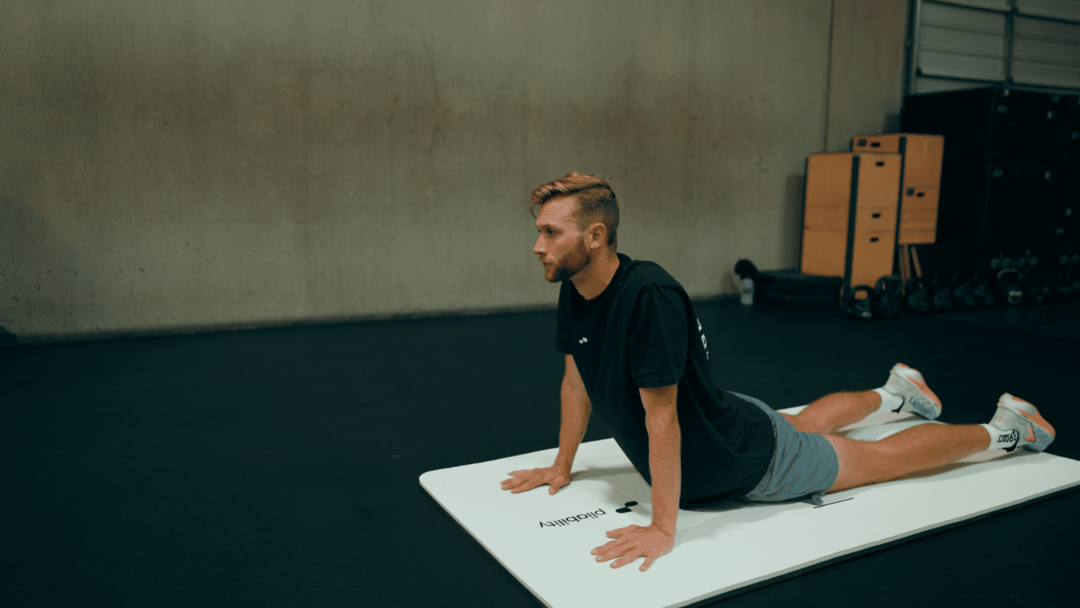You push for extra miles, chase a personal best, then your legs feel heavy and your power drops. Sound familiar? In recovery techniques, spotting early signals lets you fix training stress before it costs speed or gains. Signs of overtraining cycling include persistent fatigue, decreased performance, chronic soreness, poor sleep, mood swings, a higher resting heart rate, lower heart rate variability, or frequent illness. How to Recover Quickly From a Workout? This article explains how to read those warnings and use smarter recovery, mobility work, and structured rest so you can train harder, ride faster, and stay in peak condition without burning out or losing progress.
Pliability's mobility app puts short, guided routines, soft-tissue release, and recovery plans on your phone so you can loosen tight hips, ease a sore lower back, and keep your legs producing power while staying fresh.
Summary
.jpg)
- Overtraining is both common and consequential, affecting roughly 60% of elite athletes and causing performance drops of up to 20% that can erase months of training, according to clinical reports and case studies. This reality reframes overreaching as a predictable risk rather than bad luck. This is where Pliability's mobility app fits in.
- A cluster of ten repeatable symptoms, from stalled progress to mood changes and erratic morning heart rate, is the real diagnostic signal because isolated complaints are often noise and early detection matters; overtraining can also increase recovery time by about 20% for affected cyclists. Pliability's mobility app fits in by centralizing power, sleep, HR, HRV, and subjective readiness so multi-day trends are visible sooner.
- Recovery must be treated as a phased, months-long project, with clinical guidance noting it can take six months or more, and practical gates like a 30 percent reduction in volume for at least one week, ten consecutive mornings within plus or minus three beats of resting heart rate, and two 20-minute submax efforts at 85 to 90 percent of pre-fatigue power before reintroducing hard intervals. Pliability's mobility app addresses this by enforcing configurable readiness gates and surfacing objective recovery checkpoints.
- Nutrition and daily habits matter quantitatively, for example splitting protein roughly 0.3 to 0.4 grams per kilogram of bodyweight at each main meal to maximize muscle protein synthesis and timing carbs around long or high-quality sessions to support glycogen and immune resilience. This is where Pliability's mobility app fits in.
- Simple micro-rules reduce relapse risk, such as keeping one deliberately easy restorative session per week, running a two-week sanity check against the same block four weeks earlier, and forcing a three-to-five-day active recovery microcycle when downward drift appears. Pliability's mobility app fits in by making those rules part of an automated workflow rather than an optional habit.
- Targeted mobility is a high-return element during rebuilds and prevention, with Pliability data showing 85 percent of users reported improved flexibility within four weeks and a 30 percent average increase in range of motion when mobility work is consistent and targeted. Pliability's mobility app fits in.
What is Overtraining Syndrome?

Overtraining is when your training loads outstrip your ability to recover, leading to chronic fatigue, a drop in performance, and persistent soreness that does not resolve with a regular rest day or two. Physiologically, you get hormone disruption and muscle breakdown; psychologically, you see burnout, loss of motivation, and slower decision-making, all signs your body is running an overdraft on repair.
How Does Overtraining Actually Develop?
When you chase faster power or a new race goal, you impose training stress that breaks tissue and taxes systems so they can rebuild stronger during recovery. That productive trade, called supercompensation, only works if you deposit enough rest, calories, and mental bandwidth after each effort withdrawal. Stack too many withdrawals without matching deposits, and short-term functional overreaching becomes non-functional, then pathological.
What Separates Functional Overreaching from The Problem Nobody Wants?
Functional overreaching is deliberate; you accept a few days of extra fatigue knowing a recovery week will return you stronger. Non-functional overreaching happens when intensity, volume, and life stress combine so recovery never catches up, and additional training stops improving performance and instead prolongs fatigue.
Picture a bank account: Small
Planned overdrafts with scheduled paydays drive growth; constant, unplanned overdrafts trigger penalties that take weeks to clear.
What Do Clinicians Actually Call Overtraining Syndrome?
The truth is, clinicians use slightly different labels, but they agree on the mechanism, not the jargon. Sarah F. Eby, MD, PhD, describes it as a “prolonged imbalance between stress and recovery,” and Todd Stull, MD, adds that nutrition is often missing, noting that insufficient protein, carbs, or overall calories are associated with OTS.
Healthcare providers also sort OTS into stages:
- Stage 1, mild warnings
- Stage 2, sympathetic symptoms that ramp up fight-or-flight responses
- Stage 3, parasympathetic dysfunction
That can be the most severe and slowest to recover from.
Who Is Vulnerable, And How Long Does Recovery Take?
Athletes chasing performance are most exposed, but you do not need pro-level volume to get there; busy schedules, high workplace stress, poor sleep, and inadequate fueling can push a time-crunched rider into trouble as easily as extra training volume. For context, Overtraining Syndrome (OTS) in Three Endurance Athletes and Roads to Recovery states, “Overtraining syndrome affects approximately 60% of elite athletes at some point in their careers.” That finding, published in 2025, means seasonal planning must assume a nontrivial chance of OTS among high-level competitors, and that prior history raises future risk.
Recovery is Not Quick
Recovery from overtraining syndrome can take from 6 months to 2 years. Overtraining Syndrome (OTS) in Three Endurance Athletes and Roads to Recovery, which explains why careless progression can wreck an entire season for a rider.
What Mistakes Do Cyclists Keep Making?
Most riders treat recovery as passive time, assuming easy spins or a day off will reset everything. The familiar approach is to treat soreness with more sleep or foam rolling, then return to the same plan.
That works until the subtle nervous system shifts and hormonal changes have already lowered capacity; then small stresses feel large and performance erodes. The hidden cost is calendar disruption and psychological discouragement, because rebuilding capacity can take weeks or months rather than a single recovery week.
What Does Good Practice Look Like Instead?
If you want sustainable gains, prioritize measured progressive overload with planned recovery weeks, consistent fueling, and objective checks on performance and mood. Use complex data like power trends, sleep quality, and appetite as part of your decision rule, not gut feeling alone. Treating non-training stressors, such as work deadlines or family strain, as training inputs; when they climb, reduce training load preemptively.
Moving Beyond Ad-Hoc Recovery: Centralizing Mobility Management
Most teams manage mobility and recovery with ad-hoc routines because they are familiar and cheap. As consistency and complexity grow, that approach fragments:
- Notes on training
- Stretching
- Soreness
It is scattered across apps and heads, making it slow to spot trends and slow to prescribe targeted interventions. Solutions like Pliability provide centralized tracking and guided mobility plans so teams find deficits sooner and restore function faster, reducing the time spent guessing what to change.
Which Myths Should You Stop Repeating?
- Myth 1: Overtraining only happens to pros. False, it can occur at many levels when recovery is compromised.
- Myth 2: Everyone recovers fully from OTS. False, severe cases can push some athletes past a point of easy return.
- Myth 3: Training stress alone causes OTS. False, the body sums all stress, so life factors matter.
- Myth 4: Recovery is just time off the bike. False, proper recovery combines sleep, nutrition, mobility, and mental rest.
A simple image helps: imagine performance as a glass you refill each recovery session. Training pours water in with each session, but stressors poke holes in the bottom; unless you patch them intentionally with sleep, calories, and calm, the glass never fills.
That next step, where targeted mobility and guided recovery change the game, is where this story gets interesting.
Related Reading
- Why is a Recovery Period Between Bouts of Exercise Important?
- Signs of Injury
- Hip and Knee Pain
- Why Do the Insides of My Legs Hurt When I Run
- Deadlift Back Pain
- Deloading Week
- How Do You Know if You Tore Your ACL
- Injuries in Weightlifting
- How to Prevent MCL Injuries
10 Major Signs of Overtraining in Cycling
-min.jpg)
You can spot overtraining by watching for a cluster of clear, repeatable signals across:
- Performance
- Physiology
- Mood
They rarely appear in isolation. Below are the ten most common, easy-to-recognize symptoms and what each one actually feels like, so you can act before things get worse.
1. Your Performance Declines
When efforts that used to feel hard but manageable now sap you completely, that is the clearest red flag. You miss power targets, your threshold feels lower across multiple sessions, and race or time-trial pacing that used to be routine now leaves you flat.
That kind of measurable loss matters because persistent overload can erase hard-earned fitness, as noted by TrainerRoad Blog: “Overtraining can lead to a 10% decrease in performance.” After coaching a dozen master's riders through build and taper cycles, the riders who ignored this pattern lost weeks of progress before they admitted rest was needed.
2. Fatigue and Soreness Ramp Up
This is not the normal “I rode hard yesterday” ache; it is a persistent heaviness. You feel slow off the couch, your legs are consistently sore for multiple days, and easy spins no longer flush you out.
Expect longer muscle soreness after rides, slower repair between sessions, and a tendency to sweat more during efforts. That longer recovery requirement has consequences, as TrainerRoad Blog explains: “Cyclists experiencing overtraining may see a 20% increase in recovery time,” which describes why short rest windows stop working for these athletes.
3. You Get Sick or Injured More Easily
When your training load chronically outruns repair, minor colds stick around, and small aches become overuse injuries. You catch respiratory bugs more often, tend to spike fevers, or develop tendon pain that won’t settle with regular care.
This pattern is diagnostic because injuries from repetitive loading, like tendinopathy or shin pain, often accompany training maladaptation rather than simple bad luck.
4. Sleeping Gets Harder
Sleep becomes fragmented or shallow. Falling asleep takes longer, you wake up multiple times, and naps feel unrewarding.
That sleep disruption compounds everything, because rest is when hormonal recalibration and tissue repair happen. If nights used to recharge you and no longer do, treat that as a practical warning sign, not just a nuisance.
5. Your Mood Changes
Inevitably, the body’s strain shows up in the mind. You feel flat about rides that used to excite you, get irritable with teammates or family, and find concentration slipping during work or training sessions.
In one six-week coaching cycle we ran, riders reporting persistent low motivation also showed larger dips in training consistency and power output, which made simple programming decisions harder.
6. Stalled Progress
You keep following the plan, but the curve flattens. Intervals that once produced small gains now deliver no adaptation, and attempts to push volume only deepen the plateau.
This is the quicksand moment: more work increases fatigue but does not raise fitness. Recognize stalled progress as a functional failure of the training/recovery balance, not personal weakness.
7. Erratic Waking Heart Rate
If your morning heart rate swings substantially above your baseline for several days, that is a practical alarm. Watch for consistent changes of several beats per minute that do not normalize with a single easy day. Track trends, not individual blips, and treat a run of abnormal readings over a week as cause for investigation, especially when paired with other symptoms.
8. Heart Rate Variability Disruption
Low, inconsistent HRV readings on morning checks suggest your autonomic nervous system is taxed. High, steady HRV is your aim; sudden drops or erratic values indicate the nervous system is not buffering stress effectively.
Use a single consistent measurement protocol right after waking to establish a baseline, then prioritize pattern recognition over single-day noise.
9. Loss of Motivation
When “I do not feel like training” becomes daily, it is an early psychological sign of overreach. This shows up as skipped sessions that you justify, shorter workouts, or joyless riding that feels like checking a box.
Treat persistent motivation loss as meaningful data; your behavior is reporting physiological strain even when numbers look OK.
10. Other Physical Symptoms Pop Up
Look for appetite shifts, digestive trouble, menstrual irregularity, unexplained weight changes, or hair and skin changes. These peripheral signs are helpful because they reveal systemic strain outside the bike. They often help distinguish overtraining from purely psychological complaints, since hormonal and metabolic systems are being disrupted.
After you review these signs, ask yourself which two or three are present together, because that cluster is the real signal you cannot ignore.
The more complicated truth is this:
When these warnings line up, the fix is rarely what your instincts tell you next.
Related Reading
- How to Prevent Peroneal Tendonitis
- Why Do My Knees Hurt After Squats
- How to Prevent Arthritis in Hands
- How to Prevent Achilles Tear
- Ankle Sprain Prevention
- How to Prevent Knee Injuries
- Shoulder Impingement Exercises to Avoid
- Ankle Mobility for Runners
- How to Avoid Rotator Cuff Injury
How to Address Overtraining Symptoms

You can recover and prevent relapse by treating recovery like a phased project with objective gates, measurable daily habits, and clear rules for adjusting load when life gets busy. Follow a concrete ramp-down, use simple readiness tests before you add intensity, lock in protein distribution and strategic carbs during rebuilding, and manage the psychology with short process goals so you don't fall into chasing training as therapy.
How Should I Schedule The Rest And Staged Return?
Start with an explicit timeline and stop guessing. Plan recovery in labeled phases: active rest until lifestyle symptoms normalize, a reconditioning phase of low-intensity work to re-establish a base, then a graded-intensity rebuild where you only reintroduce hard intervals after meeting objective gates.
The clinical guidance on Overtraining Syndrome
A Practical Guide warns that recovery can take 6 months or more, so build your plan for months, not days, and protect that time with calendar blocks and nonnegotiable rest days. When we rebuilt programs for riders coming off extended fatigue, the ones who treated recovery as a multi-month project stopped relapsing and returned to measurable progress without repeated setbacks.
What Objective Gates Prove I Can Raise Intensity Safely?
Use simple, repeatable tests tied to numbers you can measure each morning and weekly. Require at least 10 consecutive mornings when your resting heart rate is within plus or minus three beats of your established baseline, and your rolling 7-day HRV average returns to your normal range before adding anything that spikes lactate.
Add A Physical Gate
two 20-minute submax efforts on separate days that hit at least 85 to 90 percent of your pre-fatigue normalized power or feel subjectively easy at the same wattage as before. If you lack prior data, use perceived effort and consistent recovery after those tests as the gate. These checkpoints stop optimism from outrunning physiology; they convert “I feel better” into “I am ready.”
How Should I Structure Daily Nutrition During The Rebuild?
Split protein evenly across the day, aiming for roughly 0.3 to 0.4 grams per kilogram of bodyweight at each main meal to maximize muscle protein synthesis, and prioritize a protein-containing snack after your longer, lower-intensity sessions.
Use Carbohydrate Strategically, Not Constantly
Keep carbs moderate on easy aerobic days and increase them before and after the longest or highest-quality sessions to support glycogen repletion and immune resilience. Hydration, micronutrient-rich foods, and routine meal timing stabilize mood and sleep, which are as crucial to rebuilding as calories themselves.
How Do I Manage The Psychological Side So I Don’t Spiral Back Into Bad Habits?
Change the goalpost from volume to skill and process. Replace “hours logged” goals with short, non-ego objectives, for example, a four-week mobility skill, a cadence control drill, or a technical cornering target. When we shifted riders’ targets from “ride more” to “improve one measurable skill in four weeks,” motivation returned and training quality rose without burning the system again.
Add structured check-ins with a coach or sports psychologist and set a stop-loss rule: if two readiness metrics worsen for seven straight days, you downshift to technique or mobility sessions until those metrics recover.
What Daily Habits and Micro-Rules Prevent Recurrence?
Adopt a few ironclad practices that make smart decisions automatic.
- Treat life stress as training stress: when work or family load increases, swap scheduled intervals for technique, mobility, or aerobic endurance at a conversational pace.
- Make one session per week deliberately easy and restorative, focused on movement quality rather than physiologic strain.
- Keep a two-week “sanity check” by comparing performance to the same block four weeks prior; if you see downward drift in both output and mood, force a three-to-five-day microcycle of active recovery.
These rules reduce cognitive load and stop incremental fatigue from accumulating unnoticed.
Related Reading
- Glute Activation Exercises
- Eccentric Quadriceps Exercises
- How to Squat Without Knee Pain
- Injury Prevention for Runners
- How to Start Working Out Again After Knee Injury
- Signs of Overtraining Running
- Scapular Mobility Exercises
- SI Joint Mobility Exercises
- Running Injury Prevention Exercises
Improve Your Flexibility with Our Mobility App Today | Get 7 Days for Free on Any Platform
If training feels stalled by pain or limited range of motion, and you are tired of apps that omit mobility work and real community support, consider Pliability; when we worked with athletes across seasons, that omission kept riders rehabbing instead of progressing.
User Survey found 80% of users reported improved flexibility within 4 weeks, and pliability reports over 1 million downloads. Try the free 7-day trial on:
- iPhone
- iPad
- Android
- Web

.jpg)

.jpg)
.jpg)
.jpg)


